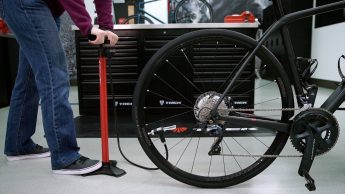This sounds funny, right? You are probably asking yourself, Does this mean I cannot pump air into my bicycle tyres? Or are there special and recommended ways of doing so.
The article doesn’t just cover the random pump in and out Procedure you might be doing with a bicycle pump, but all other factors you should consider before pumping your bike.
It may sound so basic and simple but ranging from different valve types, specific pumps for each type, the pressure required for your tyre, and how to know when your tyre has reached its maximum pressure limit, there is a lot you might love to know about pumping tyres.
As we proceed, I will be giving you tips on how often you should pump your tyres, how to know when to pump your tyres, what type of pump do you need for tyres, procedures to pumping tyres and what to do when your tyres refused to be pumped.
HOW OFTEN SHOULD YOU PUMP YOUR TYRES
Quick Navigation
As a regular bike user, it is important you note how often you should inflate your tyres. Could pump too much pose a threat to your tyre?
Deflated tyres or loosely aired tyres places you at huge risk and loss. This can lead to flat tyres and rim damage, or even damage of your spooks or wheel especially when you hit a bump or a pothole.
Deflated tyres place huge demands on the cyclist for pedalling. On a loose aired tyre, you will need a great amount of effort to keep your bicycle going.
Bicycle tyres usually hold not a huge amount of air as recommended in your bicycle manual.
But this slim amount of air is subjected to a great deal of pressure.
No matter the type of valve your bicycle uses, Schrader or Presta valves, it wouldn’t take too long for enough air to seep through your tyre and tubes, leave them all soft and deflated.
So it is necessary you pump your bicycle tyres regularly as the amount of usage will determine.
It is recommendable that high-pressure road bikes be pumped at least once a week while your mountain bike tyres deserve attention at least every two to three weeks.
How to Know when to pump your tyres
The average bike user gets to know when to pump his tyres by mere touching or feeling them.
These traditional means has been in use for years now, but it’s not all reliable as you can’t be able to detect the exact PSI on your tyre.
The perfect way of knowing when to pump your tyres is by using a gauge.
Some mini bike pumps come with Gauges attached to them. Effective use of these will let you know when your tyre deserves attention.
What type of pump do you need for your tyres
So far, We’ve known that there are 3 basic types of pumps as I’ve been discussing for a while now.
The floor/track pump, the mini pumps and CO² inflators/pumps.
Floor Pumps
These are your regular everyday heavy-duty pumps. They are usually left at home because of their bulky nature, but usually faster to use during inflation, as they release a greater amount of air into your bike tyres/tubes at required pressure.
Mini pumps
These are your emergency typed of pumps. I’ve discussed much this frequently, I believe we should be conversant with it already.
CO² Inflator
This kind of pumps are made up of a cartridge containing compressed carbon dioxide, usually use to inflate or top up a tyre at a very fast rate because of the high molecular structure of CO².
It is very necessary you note these types of pumps as they can suit perfectly depending on your situation and the swift need and deadline you need to meet up with.
HOW DOES A BICYCLE PUMP WORK
A bicycle pump is basically just a manually operated piston that performs on a double stroke – the downstroke and Upstroke.
Drawing air into the pump, with the other drawing air into the tyre as pressure is applied.
Tyres naturally hold a minimal amount of pressure, so for air to penetrate into it, you will need to exceed the pressure inside the tyre by increasing the pressure on the pump.
This is done by increasing your pump action on your bicycle pump to allow required airflow through your Bicycle’s valve to fill up the tyre.
It is nice you know that too much pressure on your tyre can cause it to blow up as load is applied to it.
This could cause damage on the rim or cause a reduction in your bicycle grip giving you a harsh ride.
Procedures to pumping your tyres
There are given rules for pumping your tyres. Sequentially following them will grant you effective filling up of your tyres.
These procedures include;
1. Determine what type of valve is placed on your bicycle
The first thing you’ll need to unravel before pumping your tyre is to determine what type of valve is fitted into your bicycle.
The first thing you’ll need to unravel before pumping your tyre is yo determine what type of valve is fitted into your bicycle.
There are two types of valves, always distinct to every bicycle. Every bicycle can either have a Schrader valve or a Presta valve.
You can easily discover which type of valve is fitted into your Bicycles by reading your bicycle’s manual or you can follow the procedure written here
It is very necessary you note the type of valve on your bike as using a Schrader pump on a Presta valve will not work, neither on the other way round no matter how hard you try.
2. Carefully unscrew your valve
For Schrader valves, all you’ll need to do is to remove the rubber cap on the tip of the valve. This leaves your tire open and ready for pumping.
For Presta valves, you’ll need to remove the cap and also loosen the threaded nut on the valve. Once released, some pressure on the valve will release some air.
3. Unlock your pump
For most mini pumps, there is usually a lever to pull up that keeps the pump unlocked. Some will need a 90-degree pull to unlock it. However, you don’t need to be confused as to how to unlock your pump, as their user manual should be there to direct you on how to do it.
4. Attach your pump to your valve
Fit in properly your pump head to the bicycle’s valve. Most mini-pumps have built-in switches that can be flipped up or down, some are designed with a threaded screw top that can fit in easily to the valve.
These designs are made to ensure that there is a perfect attachment on both sides, so as to avoid a leak of air while you pump.
After attaching your pump to your valve, it is nice you check if any amount of air is leaving the ends.
If you discover any leak on any of the sides, consider readjusting the pump and its fittings until it is perfectly aligned to the valve.
5. Pump ‘Only’ the required air pressure
This is so important as I have earlier explained what too much or low pressure can do to your bicycle.
It is necessary you use a gauge to keep at this pressure.
Reaching the required air pressure, you should unlock your pump. I’ll advise you do this gently so as not to damage your valve.
Gently remove the pump from the valve. Screw the nut on the valve and cover up the cap as the case may be.
WHAT TO DO WHEN YOUR TYRE REFUSES TO PUMP
If it seems like your tyre is not getting inflated no matter how hard your pump, then its necessary to verify and rectify using this procedure.
You must properly confirm that the nut to the valve is unscrewed, this is it you are pumping to a Presta valve.
Check if the pump head is properly fitted.
You can also add a check if there is any leak on your bicycle’s pump hose or tube. Leakages on any of both sides will give you fruitless efforts.

